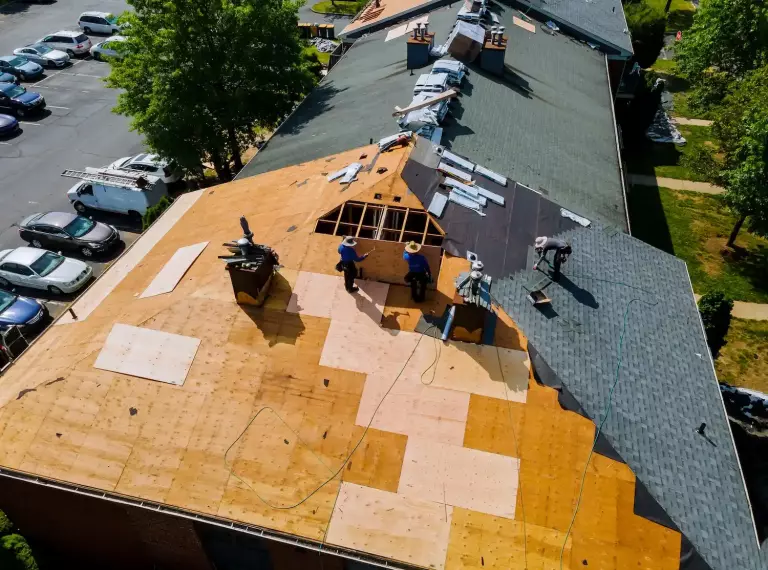When you need to replace your roof, it’s never a fun experience. However, it can be incredibly stressful if you’re dealing with an insurance claim. The good news is that most insurance companies will cover the cost of part, if not all, of a home’s roof after a large storm or another natural disaster like hail or wind damage. In this guide, we’ll go over how to negotiate roof replacement with insurance companies.
UNDERSTAND YOUR HOMEOWNERS’ INSURANCE COVERAGE
Before your roof is damaged, you’ll want to ensure you know what your homeowner’s insurance covers. Many people think their insurance will cover roof damage. Before you make a home insurance claim, it’s essential to understand what your policy covers and doesn’t cover.
WHAT INSURANCE COVERS
When it comes to roofing insurance coverage, the first thing you need to know is that there are five different types of damage that homeowner’s insurance typically covers:
- Water damage from rain, hurricanes, or similar weather events.
- Wind damage or lightning strikes.
- Unexpected falling debris, like trees or branches, breaks through your roof and causes damage inside the house.
- Some fires (not all types of fire).
- Vandalism.
Now that you know what is covered under most homeowner’s insurance policies let’s look at some things that aren’t.
WHAT INSURANCE DOESN’T COVER
You might be surprised to find your expensive insurance policy doesn’t cover 100% of all the damage that could occur to your roof. Typically, a homeowners insurance policy doesn’t cover:
- Damage caused by the homeowner.
- Poorly maintained roof leads to damage.
- Natural disasters like earthquakes, tornados, or floods.
Some homeowners don’t know what their policies cover until after they’ve already been affected by natural disasters and need their entire roof repaired.
1. ASSESS ROOF DAMAGE
Before contacting your insurance company, you first need to assess the damage to your roof.
When assessing damage to your roof, start on the ground floor. Look for damaged shingles, cracks, holes, or loose materials.
Check gutters and downspouts—debris can clog these and cause water damage. Look at flashing around chimneys and vents—this is common for water damage.
Check your attic and crawlspace for signs of mold. If you see mold or feel moisture, call an expert immediately to prevent further damage and health issues.
If you have a ladder, safety gear, and someone to assist you, climb onto the roof; otherwise, call a roofing company.
Make sure to look for cracked, curled, or missing shingles. Inspect for water damage like staining or mold growth.
2. DOCUMENT ROOF DAMAGE
After assessing the damage to your roof, you need to document the roof damage. Take photos from different angles, including below the roof and inside your attic.
In addition to taking clear pictures of the damaged area, it’s also important that your documentation includes specific details about:
- When the damage occurred (date and time)
- Where the damage occurred (address)
- Location of damage on your roof (i.e., along chimney flashing or in the attic)
- What was damaged (type of roof, shingles, etc.)
- Description of the damage, including a description of the type of damage on your roof and what caused it (i.e. wind damage)
After documenting the damage, contact the professionals.
3. ENLIST ROOFING PROFESSIONALS FOR INSPECTION
Before contacting your insurance company with the details of the damage, it’s essential to enlist the help of a reputable roofing company. A good roofing contractor will inspect the damage, determine necessary repairs, and estimate the repair costs.
Get three or four detailed estimates from different roofing professionals. Ensure that all their costs, materials, and labor are included in their written estimates.
Give them some context for their quote if any other damage-related issues need addressing during the repair process.
Ask the roofing pros if they have experience with your roofing insurance claims.
4. CONTACT INSURANCE ADJUSTER
With estimates in hand, it’s time to contact your insurance company. Call them, email them, or fill out the form on their website asking for a claims adjuster to contact you about your roof damage.
When an adjuster comes over to look at the damage, they must take notes of everything that was lost and not just visually inspect it all from one spot in the yard.
Insurance adjusters look for evidence when calculating how much money you’re entitled to receive under your policy’s terms and conditions (which dictate how much you’ll receive).
5. FILING AN INSURANCE CLAIM
Once you’ve talked to the roofing contractors and an insurance adjuster, submit a roof claim to your insurance company. Collaborate with your insurance agent to ensure you satisfy all necessary dates and conditions for prompt and complete roof replacement coverage.
You’ll have a far better chance of getting a complete settlement if you come prepared with visual evidence and several estimates from a trustworthy roof repair business.
Your adjustor will review all of this material before calling back with their decision about what they’ll pay for repairs or replacement costs.
6. PREPARE TO NEGOTIATE WITH YOUR INSURANCE COMPANY
When you’re ready to negotiate a roof replacement with your insurance company, ensure you have all your ducks in a row. Here are a few tips to ease you into the negotiation process:
- To keep your expectations in check, calculate the replacement cost of a new roof based on the current value of your home.
- Document your damaged roof with pictures and descriptions.
- Keep copies of warranties and know your roof’s age.
- Get 3-4 of your roofing estimates before the adjuster arrives.
- Meet claim paperwork deadlines and fill out all forms honestly and accurately.
- Know what your homeowner’s insurance policy says.
Keeping these tips in mind, you’ll be on your way to a smooth and successful new roof replacement claim.
7. PAYMENT AND REPLACEMENT
The insurance company will decide how much to pay for either partial roof repair or total roof replacement. Once you have that amount, schedule your contractor for immediate roof repairs.
CONCLUSION
It can be challenging to navigate the world of insurance claims for a roof replacement, but if you follow these tips, you should have no problem getting what you deserve after a disaster strikes!




